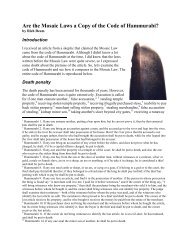DNA Evidence and Molecular Genetics Disprove the Book of Mormon
DNA Evidence and Molecular Genetics Disprove the Book of Mormon
DNA Evidence and Molecular Genetics Disprove the Book of Mormon
Create successful ePaper yourself
Turn your PDF publications into a flip-book with our unique Google optimized e-Paper software.
<strong>DNA</strong> <strong>Evidence</strong> <strong>and</strong> <strong>Molecular</strong> <strong>Genetics</strong> <strong>Disprove</strong> <strong>the</strong> <strong>Book</strong> <strong>of</strong> <strong>Mormon</strong> page 3 <strong>of</strong> 14<br />
By Rich Deem<br />
Y-chromosome<br />
The Y-chromosome is <strong>the</strong> sex-determining chromosome found only in males. This chromosome<br />
is passed down from fa<strong>the</strong>r to son, <strong>and</strong> so, records <strong>the</strong> history <strong>of</strong> descent along <strong>the</strong> male<br />
bloodline. Since it is passed down exclusively by males, <strong>the</strong>re is no recombination on <strong>the</strong><br />
chromosome, making <strong>the</strong> genetics considerably simpler than those found in <strong>the</strong> autosomal<br />
chromosomes, which recombine in each generation.<br />
These studies show that Native Americans share genetic Y-chromosome polymorphisms with<br />
Siberian Asians. One study examined, a C-->T transition at nucleotide position 181 <strong>of</strong> <strong>the</strong><br />
DYS199 locus, which was found in all five Native American populations studied. 5 The same<br />
polymorphism was found in two <strong>of</strong> nine native Siberian populations, <strong>the</strong> Siberian Eskimo <strong>and</strong><br />
<strong>the</strong> Asian Chukchi. As a control, researchers examined <strong>the</strong> DYS287 Y Alu polymorphic element<br />
insertion <strong>and</strong> an A-->G transition at DYS271, both commonly found in Africans, but found<br />
nei<strong>the</strong>r African allele associated with <strong>the</strong> DYS199T allele in any <strong>of</strong> <strong>the</strong> Native American or<br />
native Siberian populations.<br />
A second study examined <strong>the</strong> major groups <strong>of</strong> <strong>the</strong> Native American founding populations. 6<br />
Haplotype M3, accounted for 66% <strong>of</strong> male Y-chromosomes <strong>and</strong> was found associated with<br />
native populations from <strong>the</strong> Chukotka peninsula in Siberia, adjacent to Alaska. The second major<br />
group <strong>of</strong> Native American Y-chromosomes, haplotype M45, accounted for about one-quarter <strong>of</strong><br />
male lineages. This haplotype was found in <strong>the</strong> Lower Amur River <strong>and</strong> Sea <strong>of</strong> Okhotsk regions<br />
<strong>of</strong> eastern Siberia. The remaining 5% <strong>of</strong> Native American Y-chromosomes were <strong>of</strong> haplotype<br />
RPS4Y-T, which was found in <strong>the</strong> Lower Amur River/Sea <strong>of</strong> Okhotsk region <strong>of</strong> Siberia. These<br />
data suggested that Native American male lineages were derived from one or two major Siberian<br />
migrations.<br />
An analysis <strong>of</strong> 63 polymorphisms <strong>and</strong> 10 t<strong>and</strong>em repeat sequences were analyzed for 2,344 Y<br />
chromosomes from Native American, Asian, <strong>and</strong> European populations. 7 Analysis <strong>of</strong> <strong>the</strong>se<br />
sequences indicated that three major haplogroups, C, Q, <strong>and</strong> R, accounted for nearly 96% <strong>of</strong><br />
Native American Y chromosomes. Haplogroups C <strong>and</strong> Q were found to represent early Native<br />
American founding Y chromosome lineages, while haplogroup R was found to come from recent<br />
admixture with Europeans. Phylogenetic analyses <strong>of</strong> haplogroups C <strong>and</strong> Q traced both lineages<br />
to an ancestral homel<strong>and</strong> in <strong>the</strong> Altai Mountains in Southwest Siberia, from 10,100 to 17,200<br />
years ago.<br />
Ano<strong>the</strong>r study examined eight biallelic <strong>and</strong> six microsatellite polymorphisms from <strong>the</strong> Y<br />
chromosomes <strong>of</strong> 438 individuals from 24 Native American populations <strong>and</strong> in 404 Mongolians. 8<br />
5 Lell JT, Brown MD, Schurr TG, Sukernik RI, Starikovskaya YB, Torroni A, Moore LG, Troup GM, Wallace DC.<br />
1997. Y chromosome polymorphisms in Native American <strong>and</strong> Siberian populations: identification <strong>of</strong> Native<br />
American Y chromosome haplotypes. Hum. Genet. 100:536-543.<br />
6 Lell JT, Sukernik RI, Starikovskaya YB, Su B, Jin L, Schurr TG, Underhill PA, Wallace DC. 2002. The dual origin<br />
<strong>and</strong> Siberian affinities <strong>of</strong> Native American Y chromosomes. Am. J. Hum. Genet. 2002 70:192-206.<br />
7 Zegura SL, Karafet TM, Zhivotovsky LA, Hammer MF. 2004. High-resolution SNPs <strong>and</strong> microsatellite haplotypes<br />
point to a single, recent entry <strong>of</strong> Native American Y chromosomes into <strong>the</strong> Americas. Mol. Biol. Evol. 21:164-175.<br />
8 Bortolini, M., et al. 2003. Y-Chromosome <strong>Evidence</strong> for Differing Ancient Demographic Histories in <strong>the</strong> Americas.<br />
Am. J. Hum. Genet. 73: 524–539.<br />
<strong>Evidence</strong> for God from Science http://www.GodAndScience.org






